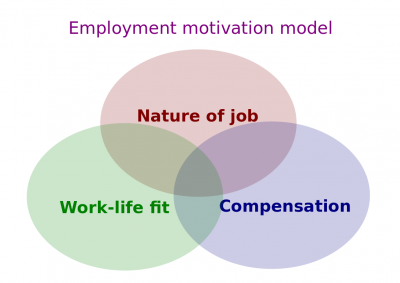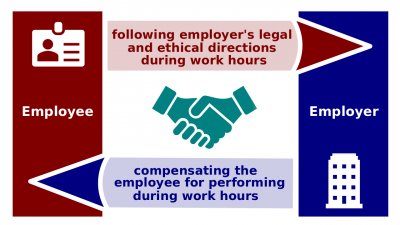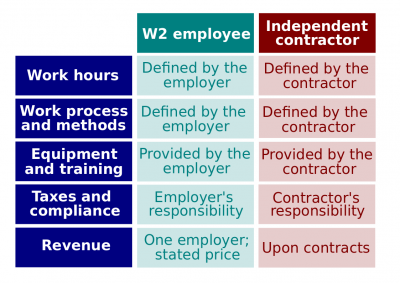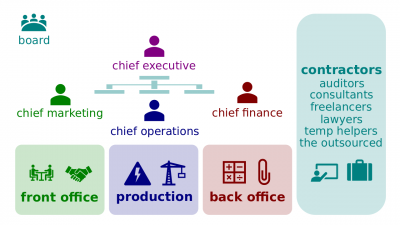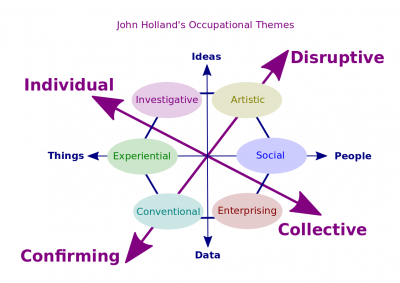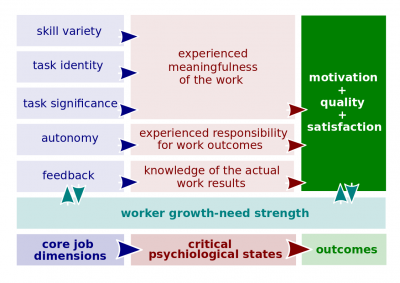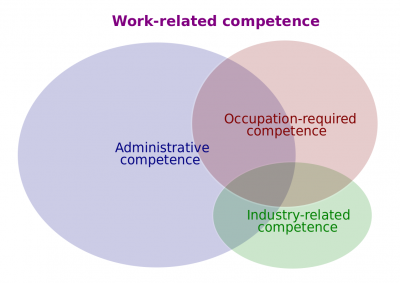Book of Employment
Introduction to Employment (hereinafter, the Session) is a learning session introducing its participants to employment and related topics. The Session consists of six lessons, each of which is made of three to five lesson parts, called lectios. Every lectio includes a presentation and a survey, not a quiz. The official version of the Session is published at CNM Cert. Its materials are also published at CNM Page, CNM Wiki, and various channels for marketing and convenience purposes.
The Session is the second of eight sessions of both CNM Cyber Orientation and WorldOpp Orientation.
Contents
Outline
In the WorldOpp Orientation, the Welcome to Friends Of CNM is the predecessor session. So is the Welcome to CNM in the CNM Cyber Orientation.
Employment Essentials
- Main wikipage: Employment Essentials; video (9:35)
- Employment. In the workspace, employment is an agreement between an employer, who agrees to compensate an employee in exchange for his or her work time, and an employee, who agrees to follow the employer's directions during work hours in exchange for the employee compensation, as well as a process and/or result of that exchange.
- Employee compensation. The cash compensation and employee benefits that an employee receives in exchange for the service he or she performs for their employer and/or for his or her time.
- Employment motivation model. A framework for analyzing employment motivation that identifies three domains that contribute to the motivation to work. These domains include job itself, its compensation, and its fit to one's life.
- Economy. The system of human production and consumption of raw materials, goods, and services, which may range from the prosperity of a single household to the wealth of nations. Economy may also refer to the way of how the wealth is generally created and used or, particularly, to the careful use and management of money, time, energy, etc.
- Worktime seller. Any individual who is in a business of selling his or her work time to employers. The sellers include employees, employment candidates, and pretty much every seller on the job market.
- Employee (in the United States, also known as W2-employee). Any individual employed by an employer for some compensation that most likely includes wages or a salary.
- Independent contractor (in the United States, also known as 1099-form worker) is a contractor, who is an individual who provides any legal entity with his or her products, usually, services. The Contractor's products are specified under terms of a contract or a verbal agreement.
- Self-employed. The state of working for oneself as a freelance or the owner of a business rather than for an employer.
- Apprentice. Any employee who is not fully qualified to perform his or her workload, but agreed to work usually for a part of the fully-skilled worker compensation under the condition of educational assistance in order to gain the needed work-related competence.
- Volunteer. A person who does something, especially helping other people, willingly and without being forced or paid to do it.
- Employment candidate. Any candidate in a search for employment as an employee.
- Intern. A student in some professional field or recent graduate from an educational program gaining supervised practical experience in the workplace.
- Paid intern. An intern who is compensated for his or her work time at a regular employee level or some percentage of a regular employee compensation.
- Unpaid intern. An intern who is not compensated for his or her work time.
- Economy sector. An area of the economy in which enterprises share one of four groupings of produced products: (a) raw materials, (b) physical goods to be eventually consumed by end users(c) physical, non-digital services such as retail, tourism, traditional banking, entertainment, etc., and (d) digital products.
- Primary sector. The economy sector that groups those enterprises that extract from the nature, renew, and pre-process those raw materials or substances such as agriculture and mining products that the manufacturing industry will further process in order to create those goods and services that can be eventually consumed by end users.
- Secondary sector. The economy sector that groups those enterprises that produce physical goods to be eventually consumed by end users.
- Tertiary sector. The economy sector that groups those enterprises that produce physical, non-digital services such as retail, tourism, traditional banking, entertainment, etc.
- Quaternary sector. The economy sector that groups those enterprises that produce digital products.
- Labor relations.
- Labor organization. Any organization of any kind, or any agency or employee representation committee or plan, in which employees participate and which exists for the purpose, in whole or in part, of dealing with employers concerning grievances, labor disputes, wages, rates of pay, hours of employment, or conditions of work.
- Labor union. An association of employees that represents a bargaining unit in order to negotiate, execute, and/or manage a collective bargaining agreement.
- Collective bargaining agreement (CBA).
Industries and Specialties
- Main wikipage: Industries and Specialties
- Industry. The part of any economy sector that groups those enterprises that create a particular type of products.
- Industry relations. The systematic study of attitudes, motivations, and behaviors which two or more legal entities within the same industry assume toward each another.
- Industry constituency. Any group of legal entities that are involved in, served by, patronize, support, offer representation, or are likely to be involved, served, patronize, support, or offer representation for a particular industry.
- Industrial classification.
- Raw materials industry. Alternative name for the primary sector.
- Infrastructure industry. The industry that groups those enterprises that supply and present all substances, materials, and properties such as energy, water, buildings, and roads that human beings, other entities, and their equipment are needed in order to function, as well as dispose and/or utilize the processed substances, materials, and properties. This industry includes both construction and utility enterprises.
- Manufacturing industry. The industry that groups those enterprises that process raw materials into those goods and services such as food, clothing, paper, and machinery, that can be eventually consumed by end users.
- Transportation industry. The industry that groups those enterprises that deliver human beings and goods from one geographical point to another. In addition to transport enterprises, this industry includes warehouse and postal services.
- Digital industry. The industry that groups those enterprises that produce software and/or provide their customers with software-based services such as broadcasting, telecommunication, multimedia, data processing.
- Market exchange industry. The industry that groups those enterprises that buy, sell, and/or support market exchange of products that have been produced by other entities. This industry includes franchising, real estate, wholesale, retail trade enterprises.
- Enterprise support industry. The industry that groups those enterprises that support enterprise efforts through banking, insurance, investment management, accounting, management consulting, and legal services.
- Public service industry. The industry that groups those enterprises that provide the general public with defense, public administration, public safety, and compulsory social security services.
- Healthcare industry. The industry that groups those enterprises that provide their customers with pharmacy and medical services.
- Human development industry. The industry that groups those enterprises that provide its customers with educational, training, or community outreach services.
- Live-sustaining industry. The industry that groups those enterprises that provide its customers with cleaning, entertainment, library, recreation, rental, tourism, wellness and other live-sustaining services.
- Professional specialty. A subject that is the area of expertise of some professional.
- Arts professional. The professional who engages in the creative arts for a living.
- Finance professional. The professional who engages in the finance for a living.
- Health professional. The professional who engages in the health care and wellness for a living.
- Human development professional. The professional who engages in human development for a living.
- Information professional. The professional who engages in the for information administration, ownership, and/or management a living.
- Law professional. The professional who engages in the law for a living.
- Marketplace professional. The professional who engages in the market exchanges for a living.
- Media professional. The professional who engages in the media for a living.
- Project professional. The professional who engages in project administration, ownership, and/or management for a living.
- Property administrator. The professional who engages in property administration for a living.
- Research professional. The professional who engages in the research for a living.
Nature of Occupations
- Main wikipage: Nature of Occupations; video (6:09)
- Occupation. The regular activity that a person undertakes in order to earn his or her livelihood. That activity can be a job, profession, or position that somebody works in. Entrepreneurs may refer their occupation as self-employed.
- Occupation list. Any attempt to classify various occupations. No one can be considered 'compete' or 'final.'
- Assistant. Someone who helps someone else to do a job. As an adjective, this term can also be used to indicate that someone holds a less important position in an organization than another person without this adjective, assistant, in his or her job title.
- Clerk. Someone who works in an office, dealing with records and/or performing general customer support and/or document management duties.
- Consultant. Someone who advises other people and/or enterprises on one or more particular subjects. A consultant can also be defined as a specialist and social worker combined. Advanced consultants tend to be subject matter experts on the one hand and skilled in working with people on the other hand.
- Laborer. Someone who does physical work, which requires those KSAs that can be learned fast and easily.
- Manager. Someone who achieves those goals that are assigned to him or her through his or her subordinates.
- Operator. Someone who makes something like machinery or other equipment work or puts something into action.
- Originator. Someone who creates and shapes new concepts, as well as makes them real or participates in the developments of real deliverables often as a product owner.
- Service worker (social service worker, pink-collar worker). Someone whose labor is related to social interaction and/or other service-oriented work. Service workers can be engaged in customer support, entertainment, sales, social work, etc.
- Specialist. Someone who has significant experience, knowledge, or skill in a particular subject.
- Technician. Someone whose job is to make sure that machinery, other equipment, and pieces of technology such as laboratories work correctly, which may include to make them work if they don't.
- Trades worker. Someone who is practically skilled in some area of advanced physical work like carpentering, construction, equipment installing, plumbing, printing, and welding, carries out his or her work by hand, and has learned his or her skill completely or primarily on the job in at least one year and, usually, from some mentor.
- Holland Occupational Themes. Consultant, manager, specialist.
- Experiential occupation (realistic occupation, motoric occupation). An occupation that frequently involves work activities that include practical, hands-on problems and solutions. They often deal with plants, animals, and real-world materials like wood, tools, and machinery. Many of the occupations require working outside, and do not involve a lot of paperwork or working closely with others. Examples of that type of occupations may include a carpenter, engineer, farmer, operator, technician, tester, and trades worker. Collectively, they may be called "doers;" in ancient times, they would have been hunters.
- Investigative occupation (intellectual occupation). An occupation that frequently involves working with ideas and requires an extensive amount of thinking. These occupations can involve searching for facts and figuring out problems mentally. Examples of that type of occupations may include an auditor, business analyst, compliance officer, cost estimator, editor, inspector, interviewer, and lawyer. Collectively, they may be called "thinkers;" in ancient times, they would have been shamans.
- Artistic occupation (esthetic occupation). An occupation that frequently involves working with forms, designs and patterns. They often require self-expression and the work can be done without following a clear set of rules. Examples of that type of occupations may include an artist, composer, creative writer, designer, enterprise architect, and originator. Collectively, they may be called "innovators;" in ancient times, they would have been artisans.
- Social occupation (supportive occupation). An occupation that frequently involves working with, communicating with, and teaching people. These occupations often involve helping or providing service to others. Examples of that type of occupations may include a career counselor, job coach, mediator, sales representative, service worker, and teacher. Collectively, they may be called "helpers;" in ancient times, they would have been healers.
- Enterprising occupation (persuasive occupation). An occupation that frequently involves starting up and carrying out projects. These occupations can involve leading people and making many decisions. Sometimes they require risk taking and often deal with business. Examples of that type of occupations may include an architect, product owner, and self-employed. Collectively, they may be called "creators;" in ancient times, they would have been leaders.
- Conventional occupation (conforming occupation). An occupation that frequently involves following set procedures and routines. These occupations can include working with data and details more than with ideas. Usually there is a clear line of authority to follow. Examples of that type of occupations may include an accountant, assistant, bookkeeper, clerk, document management specialist, laborer, and technical writer. Collectively, they may be called "organizers;" in ancient times, they would have been guardians.
Work Environments
- Main wikipage: Work Environments; video (5:29)
- Job characteristics model. A framework for analyzing and designing jobs that identifies five core job dimensions, their interrelationships, and their impact on outcomes. These core job dimensions include skill variety, task identity, task significance, autonomy, and feedback.
- Skill variety. The degree to which a job requires a variety of activities so that an employee can use a number of different skills and talents.
- Task identity. The degree to which a job requires completion of a whole and identifiable piece of work.
- Task significance. The degree to which a job has a substantial impact on the lives or work of other people.
- Autonomy. The degree to which a job provides substantial freedom, independence, and discretion to the individual in scheduling work and determining the procedures to be used in carrying it out.
- Feedback. The degree to which carrying out the work activities required by a job results in the individual obtaining direct and clear information about the effectiveness of his or her performance.
- Task structure. A set of structural job characteristics with which the worker interacts.
- Consequence of error. How serious would the result usually be if the worker made a mistake that was not readily correctable?
- Degree of automation. How automated is the job?
- Freedom to make decisions. How much decision making freedom, without supervision, does the job offer?
- Frequency of decision-making. How frequently is the worker required to make decisions that affect other people, the financial resources, and/or the image and reputation of the organization?
- Impact on enterprise. What results do your decisions usually have on other people or the image or reputation or financial resources of your employer?
- Importance of being exact (or accurate). How important is being very exact or highly accurate in performing this job?
- Importance of repeating same tasks. How important is repeating the same physical activities (e.g., key entry) or mental activities (e.g., checking entries in a ledger) over and over, without stopping, to performing this job?
- Level of competition. To what extent does this job require the worker to compete or to be aware of competitive pressures?
- Structured versus unstructured work. To what extent is this job structured for the worker, rather than allowing the worker to determine tasks, priorities, and goals?
- Time pressure. How often does this job require the worker to meet strict deadlines? How important is it to this job that the pace is determined by the speed of equipment or machinery? (This does not refer to keeping busy at all times on this job.)
- Work schedule. How regular are the work schedules for this job and what is the number of hours typically worked in one week?
- Work virtualization. The degree to which work is done remotely rather than at some specific physical location.
Work Competences
- Main wikipage: Work Competences; video (3:49)
- Work-related competence. Competence needed to perform productively in a particular occupation and, often, in a particular industry.
- Occupation-required competence. Competence required for a particular occupation.
- Industry-related competence. Competence related to work in a particular industry.
- Administrative competence. Competence needed to undertake enterprise efforts conceptually, regardless of specific industry or occupation.
- Operational competence (technical competence, technical skills). Knowledge, skills, and abilities needed to perform the most of jobs. That competence includes capacity to read, write, analyze, use computers, etc.
- Interpersonal competence (human competence, interpersonal skills, people skills). Knowledge, skills, and abilities needed to work with other people individually and in a group. That competence includes capacity to listen actively, communicate, understand other's motivation, etc.
- Enterprise competence (organizational competence, organizational skills, conceptual competence). Knowledge, skills, and abilities needed to undertake enterprise efforts as well as to work in and with enterprises. That competence includes capacity to navigate organizations and bureaucracies, plan resources, research for and execute regulatory compliance, etc.
Labor Regulations
- Main wikipage: Labor Regulations
- Labor law (labour law, employment law). A set of government rules that regulate relationships between employees, employers, trade unions and the government. Government agencies usually enforce that set of laws.
- National Labor Relations Act (Wagner Act). The cornerstone of United States federal labor law. The act was the first in history to give most private sector employees the right to organize into unions, to bargain collectively with employers, to define unfair labor practices by employers, and to create the NLRB.
- Fair Labor Standards Act (FLSA). The labor law that requires employers to pay covered employees at least the federal minimum wage and overtime pay of one-and-one-half-times the regular rate of pay for work exceeding a 40-hour week.
- Civil Rights Act.
- Occupational Safety and Health Act (OSH Act). The labor law that encourages safer workplace conditions in the United States. This law established the federal Occupational Safety and Health Administration (OSHA) to set standards and perform inspections at job sites. In some states, an OSHA-approved state agency helps enforce job safety standards, which must be at least as stringent as federal guidelines.
- Americans with Disabilities Act (ADA).
- Family and Medical Leave Act (FMLA). Passed by the United States Congress and signed by President Bill Clinton in 1993, this labor law affords eligible employees up to 12 weeks of unpaid leave per year if they decide to stay home in the wake of their child's birth or adoption, or serious personal or family member illness. The law only applies to businesses that employ at least 50 employees within a 75-mile radius. To receive FMLA benefits, an employee must have been with the employer for at least one year and worked at least 1,250 hours during the past 12 months.
- Whistleblower. A person who exposes secretive information or activity that is deemed illegal or unethical. In some countries, labor laws protect whistleblowers from potential retaliation that may otherwise include termination of employment, demotion, suspension, threats or harassment, and discrimination.
- OSHA's Whistleblower Protection Program. The main body responsible for protecting the rights of employees, who may fear job loss or other reprisals if they speak up. Workers who feel they have suffered retribution for reporting company violations should file a complaint with their local OSHA office within 30 days of the incident.
- Whistleblower Protection Act. The federal labor law that was initially enacted in 1989 and enhanced in 2012 that specifically protects those people who work for the United States Federal Government and report on illegal or improper activities conducted by this government or its parts.
Introduction to Recruitment is the successor session.
Preview presentations
Video
- The video preview presentation, 1:11 minutes, is published at https://youtu.be/CBuSoaw11cQ. Here is its full text:
Preview of introduction to employment session. In employment session we will talk about employment in general, we will talk about different industries, we will touch a little bit labor law. Labor law can be a separate course, we will touch different employment roles including employees and private contractors, self-employed, apprentice and volunteers, we will talk and classify different occupations. We will discuss work environments including employment motivation model, job characteristics model. We will talk about task structures and we will end up with competencies needed at work including occupation-required competencies, industry related and we will end up with administrative competencies. Next we will go to introduction to recruitment as a successor session.

